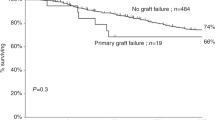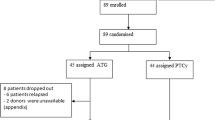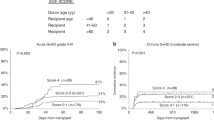Summary:
Severe graft-versus-host disease (GvHD) refractory to corticosteroids responds poorly to experimental treatment and is often fatal. Attempts have been made to ‘rescue’ such patients by transfusing autologous cells in order to ablate the lymphoid component of the graft or to introduce regulatory cells capable of suppressing the GvHD. Here, we report details of eight patients with severe grade III–IV acute GvHD (n=7) or extensive chronic GvHD (n=1) who after failing a median of four lines of treatment were then treated with either autologous or syngeneic nucleated cell transfusions. Patients received standard conditioning (n=3), low intensity (n=2) or no conditioning (n=3) before the rescue procedure. In four of the five patients who received some form of conditioning, mixed chimerism or complete recipient hematopoiesis was restored. The GvHD resolved in four patients, of whom one died subsequently of multiorgan failure and two died of leukemia; one is still alive. A fifth patient had transient improvement in GvHD, which recurred when the corticosteroids were reduced. Three patients obtained no benefit from the procedure. We conclude that ‘rescue’ by transfusion of autologous or syngeneic nucleated cells may be valuable to treat severe refractory GvHD; the best approach to conditioning remains to be defined.
This is a preview of subscription content, access via your institution
Access options
Subscribe to this journal
Receive 12 print issues and online access
$259.00 per year
only $21.58 per issue
Buy this article
- Purchase on Springer Link
- Instant access to full article PDF
Prices may be subject to local taxes which are calculated during checkout
Similar content being viewed by others
References
Gratwohl A, Brand R, Apperley J et al. Graft-versus host disease and outcome in HLA-identical sibling transplantation for chronic myeloid leukemia. Blood 2002; 100: 3877–3886.
Ferrara J, Teshima T . Understanding the alloresponse: new approaches to graft-versus-host disease prevention. Semin Hematol 2002; 39: 15–22.
Mehta J, Powles R, Singhal S et al. Outcome of autologous rescue after failed engraftment of allogeneic marrow. Bone Marrow Transplant 1996; 17: 213–217.
McSweeney P, Niederwieser D, Shizuru J et al. Hematopoietic cell transplantation in older patients with hematologic malignancies: replacing high-dose cytotoxic therapy with graft-versus-tumor effects. Blood 2001; 97: 3390–3400.
Taylor PA, Friedman TM, Korngold R et al. Tolerance induction of alloreactive T cells via ex vivo blockade of the CD40:CD40L costimulatory pathway results in the generation of a potent immune regulatory cell. Blood 2002; 99: 4601–4609.
Bordignon C, Thomis D, Marktel S et al. A Fas-based suicide switch in human T cells for the treatment of graft-versus-host disease. Blood 2001; 97: 1249–1257.
Taylor PA, Lees CJ, Blazar BR . The infusion of ex vivo activated and expanded CD4(+)CD25(+) immune regulatory cells inhibits graft-versus-host disease lethality. Blood 2002; 99: 3493–3499.
Edinger M, Hoffmann P, Ermann J et al. CD4+CD25+ regulatory T cells preserve graft-versus-tumor activity while inhibiting graft-versus-host disease after bone marrow transplantation. Nat Med 2003; 9: 1144–1150.
Martin PJ, Schoch G, Fisher L et al. A retrospective analysis of therapy for acute graft-versus-host disease: secondary treatment. Blood 1991; 77: 1821–1828.
Weiss L, Slavin S . Prevention and treatment of graft-versus-host disease by down-regulation of anti-host reactivity with veto cells of host origin. Bone Marrow Transplant 1999; 23: 1139–1143.
Pusic I, Pavletic SZ, Kessinger A et al. Pseudoautologous blood stem cell transplantation for refractory chronic graft-versus-host disease. Bone Marrow Transplant 2002; 29: 709–710.
Nagashima T, Sato F, Chuma T et al. Chronic demyelinating polyneuropathy in graft-versus-host disease following allogeneic bone marrow transplantation. Neuropathology 2002; 22: 1–8.
Westermann J, Bode U . Distribution of activated T cells migrating through the body: a matter of life and death. Immunol Today 1999; 20: 302–306.
Wiesmann A, Bader P, Bamberg M et al. Severe acute graft-versus-host disease after T-cell depleted allogeneic stem cell graft from a second donor caused by persisting T-cells from the 1st donor. Bone Marrow Transplant 2003; 32: 511–513.
Taranova AG, Georges GE, Yunusov M et al. Breaking tolerance in stable mixed chimeric dogs with low-dose TBI and donor or recipient lymphocyte infusion. Blood 2003; 102: 76a (Abstr. 256).
Author information
Authors and Affiliations
Corresponding author
Rights and permissions
About this article
Cite this article
Passweg, J., Orchard, K., Buergi, A. et al. Autologous/syngeneic stem cell transplantation to treat refractory GvHD. Bone Marrow Transplant 34, 995–998 (2004). https://doi.org/10.1038/sj.bmt.1704658
Received:
Accepted:
Published:
Issue Date:
DOI: https://doi.org/10.1038/sj.bmt.1704658
Keywords
This article is cited by
-
Prognostic factors and outcomes of severe gastrointestinal GVHD after allogeneic hematopoietic cell transplantation
Bone Marrow Transplantation (2014)
-
Paternal bone marrow infusion as salvage therapy for severe GVHD following maternal haploidentical transplantation resulting in biparental chimerism
International Journal of Hematology (2013)
-
The harvest and use of autologous back-up grafts for graft failure or severe GVHD after allogeneic hematopoietic stem cell transplantation: a survey of the European Group for Blood and Marrow Transplantation
Bone Marrow Transplantation (2008)
-
Reversal of severe graft-versus-host disease after nonmyeloablative matched unrelated donor stem cell transplant by infusion of backup autologous peripheral blood stem cells
Bone Marrow Transplantation (2005)



